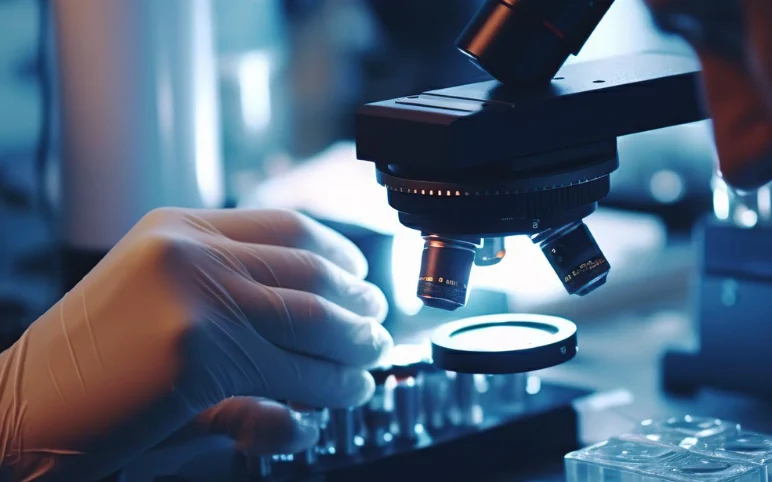Nerveblox, the Ultrasound AI for Regional Anesthesia Received FDA Clearance
On August 18, 2025, Nerveblox, an AI-powered software developed by SmartAlpha to assist physicians in performing ultrasound-guided regional anesthesia, received U.S. Food and Drug Administration (FDA) 510(k) clearance. This milestone enables SmartAlpha to introduce its technology to the U.S. healthcare market at a time when AI’s integration into clinical practice is gaining unprecedented importance.
Nerve block procedures involve injecting anesthetics to numb a specific area, providing effective pain relief for both surgical interventions and chronic pain management. Conducted under ultrasound guidance, these procedures can enhance patient recovery, reduce hospital stays, and minimize reliance on opioids while supporting quicker return to daily activities.
Nerveblox is designed to detect and highlight 50 critical anatomical structures in real time during ultrasound scanning. By identifying and displaying anatomy as physicians perform nerve block procedures, the software supports a wide range of clinical applications from cesarean sections and breast surgeries to knee and shoulder interventions, as well as pain relief in fractures and trauma cases.
Commenting on the approval, SmartAlpha co-founder Utku Kaya noted, “Ultrasound guidance is increasingly preferred for nerve blocks as it enhances accuracy and reduces complication risks. With this FDA clearance, we are advancing our mission of empowering healthcare professionals worldwide to perform ultrasound imaging with greater precision and confidence.”
Looking ahead, SmartAlpha is focused on scaling commercialization, forging partnerships, and expanding the global reach of Nerveblox. The solution has already secured regulatory approvals in Europe, the UK, and Australia earlier in 2025, further strengthening its international footprint.
“By harnessing AI, we can elevate procedural decision-making to enhance accuracy, and accelerate the adoption of ultrasound-guided pain relief strategies that improve patient outcomes,” said Dr. Gary Schwartz, MD, FASA, FASRA, Director of AABP Integrative Pain Care and Wellness. “Having utilized the Nerveblox technology at our research center and contributed to the pivotal trial, I have seen firsthand the potential of this technology to advance precision and safety of interventional ultrasound.”
As per DelveInsight’s “Anesthesia Ultrasound Systems Market Report,” the anesthesia ultrasound systems market was valued at USD 300 million in 2024, growing at a CAGR of 7.0% during the forecast period from 2025 to 2032 to reach USD 700 million by 2032. The market for Anesthesia Ultrasound Systems is being driven by several key factors. The growing preference for ultrasound-guided regional anesthesia over traditional techniques is boosting adoption, as it improves accuracy, patient safety, and procedural outcomes. Rising surgical volumes worldwide, coupled with the increasing need for minimally invasive procedures, are also accelerating demand. Furthermore, the integration of artificial intelligence in medical imaging is transforming anesthesia ultrasound systems by enabling automated nerve detection, image enhancement, and real-time guidance, which reduces operator dependency and improves efficiency. Growing awareness among anesthesiologists, along with supportive training programs and technological advancements, continues to strengthen the market outlook, making anesthesia ultrasound systems a critical tool in modern surgical practice.
Labcorp Launched First FDA-Cleared Blood Test for Alzheimer’s Disease
On August 18, 2025, Labcorp, a global leader in advanced laboratory services, announced the nationwide availability of the Lumipulse® pTau-217/Beta Amyloid 42 Ratio test, the first FDA-cleared blood-based in vitro diagnostic (IVD) designed to aid in the diagnosis of Alzheimer’s disease. Developed by Fujirebio Diagnostics, Inc., this test enables early detection of amyloid plaques, a hallmark of the disease, in appropriate patients.
Unlike traditional diagnostic approaches such as cerebrospinal fluid (CSF) testing via lumbar puncture or positron emission tomography (PET) scans, the Lumipulse test requires only a simple blood draw making it less invasive, more accessible, and cost-effective. According to Fujirebio, clinical studies demonstrated a positive predictive value of 92% and a negative predictive value of 97%, underscoring its reliability in supporting diagnostic decisions.
The launch aligns with the latest Alzheimer’s Association clinical guidelines, which endorse the use of blood-based biomarkers to assist in evaluating patients with suspected Alzheimer’s disease in specialty care settings. These guidelines reflect the growing consensus on the clinical value of such tools and highlight the need to broaden access.
The Lumipulse pTau-217/Beta Amyloid 42 Ratio test is intended for adults aged 50 years and older who present with signs of cognitive decline in specialized care environments. It is not a screening tool or a stand-alone diagnostic, but should be used alongside other clinical information. Patients can complete the blood draw either at their healthcare provider’s office or at one of Labcorp’s 2,200+ Patient Service Centers (PSCs) nationwide.
“The path to an Alzheimer’s diagnosis has long meant a diagnostic journey requiring years of invasive procedures and expensive imaging,” said Dr. Brian Caveney, chief medical and scientific officer at Labcorp. “Clinicians need better ways to diagnose their patients more quickly, enroll them in clinical trials, or start therapies. By offering this FDA-cleared blood test nationwide, Labcorp is leading the way in delivering innovative solutions for Alzheimer’s disease and other neurological conditions by helping patients, families, and physicians get answers sooner.”
As per DelveInsight’s “Alzheimer’s Disease Diagnostic Market Report”, the global Alzheimer’s disease (AD) diagnostic market will grow at a CAGR of 10.97% during the forecast period from 2024 to 2030. The Alzheimer’s disease (AD) diagnostic market is observing an optimistic market growth due to factors such as a rise in the regulatory approvals for Alzheimer’s disease (AD) diagnostics across the globe. Further, the rising prevalence of head injuries owing to accidents, workplace injuries, and others, and the rise in the geriatric population will increase the prevalence of Alzheimer’s disease, thereby increasing the demand for Alzheimer’s disease diagnostic devices across the globe. Additionally, the increasing research and development of novel biomarkers, the presence of key players in the market, increasing product launches and approvals, and other factors will create a need for Alzheimer’s disease diagnostics in the upcoming years. Therefore, the market for Alzheimer’s disease (AD) diagnostics is estimated to grow at a substantial CAGR during the forecast period from 2024 to 2030.
Calidar Announced Groundbreaking 4D Mammography System: First-in-Human Study Initiated
On August 19, 2025, Calidar, Inc., a pioneering start-up in precision diagnostic imaging, announced the successful imaging of the first patient using its breakthrough 4D Mammography system. This next-generation platform combines X-ray diffraction with artificial intelligence to capture molecular-level disease signals, offering the potential to significantly enhance diagnostic accuracy. The procedure marks the first known in-human measurement of X-ray diffraction spectra, an important milestone in advancing medical imaging.
Despite decades of progress in imaging technologies, detecting breast cancer and other soft tissue diseases with high noninvasive precision remains challenging. In the U.S. alone, approximately 1.5 million breast biopsies are performed each year, yet up to 80% (around 1.2 million) are later confirmed as benign. These unnecessary interventions contribute to over $6 billion in annual healthcare costs, while also burdening patients and payers. Furthermore, inconclusive imaging often delays diagnosis, leading to an estimated 50,000 breast cancer patients each year facing postponed treatment, raising costs and lowering survival rates. Clinicians are also impacted, as radiologists have seen workloads nearly double and pathologists face more than a 40% increase in case volumes over the last decade.
The 4D Mammography system, developed by Calidar’s founding team, Stefan Stryker, Josh Carpenter, and Mitchell Greene, aims to overcome these limitations by analyzing how X-rays scatter at the molecular level, a process known as X-ray diffraction. This generates a distinctive structural fingerprint that reveals tissue composition rather than just shape and density, as in conventional X-ray imaging. In earlier ex vivo breast tissue studies, these unique molecular signatures demonstrated fourfold greater accuracy in distinguishing between cancerous and benign samples compared to traditional imaging methods.
The ongoing first-in-human study will evaluate the system’s ability to differentiate healthy tissue from breast cancer and benchmark its performance against standard mammography. The trial is being conducted in collaboration with Baptist Health Hardin in Elizabethtown, KY, under the leadership of Principal Investigator Craig Kamen, MD.
While the current trial focuses on diagnostic applications in patients with suspicious findings, future studies are planned to explore its role in routine breast cancer screening. The ultimate goal is to enable earlier detection and improved patient outcomes on a broader scale.
At present, the 4D Mammography system is investigational and has not yet been cleared or approved by the U.S. Food and Drug Administration. It is not commercially available and is being used strictly under the FDA’s abbreviated IDE requirements for investigational purposes.
“This is more than a study milestone; this is the start of a new era of medical imaging,” said Dr. Stryker, CEO of Calidar. “X-ray diffraction has unlocked some of the most iconic achievements in science, from discovering the structure of DNA to revealing the composition of another world on the Mars rover and now we are bringing its power into the clinic to look inside the human body in a completely new way. Our 4D Mammography system brings this capability to the challenge of breast cancer diagnostics, where high-precision, noninvasive imaging tools are urgently needed.”
“We are excited to collaborate on this next-generation research and contribute to the development of technology that could meaningfully enhance our capabilities for diagnosing breast cancer,” said Dr. Kamen.
According to DelveInsight’s “Mammography Devices Market Report”, the mammography devices market was valued at USD 1.78 billion in 2023, growing at a CAGR of 9.15% during the forecast period from 2024 to 2030, to reach USD 3.65 billion by 2030. The market for Mammography Devices is primarily driven by the rising prevalence of breast cancer, which continues to be one of the most common cancers among women worldwide, thereby increasing the need for early detection and diagnosis. Growing awareness campaigns by governments and healthcare organizations are encouraging more women to undergo regular screening, further fueling demand. Technological advancements, such as the shift from analog to digital mammography and the adoption of 3D tomosynthesis, are enhancing image quality, improving detection rates, and reducing false positives, which boosts physician confidence and patient acceptance. Additionally, the integration of artificial intelligence in medical imaging is playing a crucial role in automating image analysis, improving diagnostic accuracy, and reducing interpretation time for radiologists. Expanding healthcare infrastructure in emerging economies, increasing investments in diagnostic imaging centers, and supportive reimbursement policies in developed regions are also significant market drivers. Together, these factors are creating a strong growth trajectory for mammography devices, positioning them as essential tools in early cancer diagnostic and precision diagnostics.
ONWARD Medical Received FDA IDE Approval to Initiate the Empower BP Pivotal Study with the ARC-IM System
On August 18, 2025, ONWARD Medical N.V., a leading neurotechnology company developing therapies to restore movement, function, and independence for people with spinal cord injury (SCI) and other mobility impairments, announced today that the U.S. Food and Drug Administration (FDA) has granted Investigational Device Exemption (IDE) approval for its ARC-IM System. This clearance allows the company to launch the Empower BP pivotal study, which will evaluate the safety and effectiveness of the spinal implants stimulation system for treating blood pressure instability following SCI.
Empower BP marks ONWARD’s second global pivotal trial and the first to investigate the ARC-IM System. The randomized, double-blind, sham-controlled study will enroll patients across approximately 20 leading neurorehabilitation and neurosurgical research centers in the U.S., Canada, and Europe, with first patient enrollment expected before year-end. Eligible participants will include individuals with spinal cord injuries between levels C2 and T6, classified as AIS A–D, who experience blood pressure instability, including chronic orthostatic hypotension (OH) and episodes of autonomic dysreflexia (AD).
Blood pressure instability affects more than 50% of people with SCI, impacting nearly 350,000 individuals in the U.S. and Europe. Persistent hypotension and unstable blood pressure not only threaten neurological recovery but also increase cardiovascular risks and diminish quality of life. Common symptoms include dizziness, lightheadedness, blurred vision, and fatigue.
The ARC-IM System is the first implantable neuromodulation platform specifically designed to manage blood pressure instability in SCI patients. It consists of the ONWARD Neurostimulator (IPG) and the ARC-IM Thoracic Lead, optimized for placement in a key region of the thoracic spinal cord known as the “Hemodynamic Hotspot.” This anatomical target was identified through collaborative research with the Swiss Federal Institute of Technology Lausanne (EPFL), Centre Hospitalier Universitaire Vaudois (CHUV), and the University of Calgary, and published in Nature in January 2021.
In December 2022, ONWARD reported positive interim results from feasibility studies, showing significant improvements in blood pressure regulation and overall hemodynamic stability in SCI patients. Participants not only experienced immediate and sustained improvements in blood pressure but also reduced or discontinued the use of anti-hypotension medications. Additionally, patients reported enhanced well-being, decreased dizziness, and higher energy levels. Full interim study results are expected later this year.
Addressing blood pressure instability remains one of the most pressing unmet needs in SCI management. Reflecting this, the FDA has granted ONWARD one of its 10 Breakthrough Device Designations, recognizing the ARC-IM System as a pioneering therapy with potential regulatory and reimbursement advantages.
“Blood pressure instability, especially chronic low blood pressure, is one of the most hidden and unrecognized functional complications of spinal cord injury,” explains Dr. James Guest, neurosurgeon and Professor of Neurological Surgery at the University of Miami. “It leaves people feeling unwell and can significantly impact their overall quality of life. Blood pressure instability also increases the risk of cardiovascular disease, making addressing this unmet need critical for improving the long-term outcomes of SCI.”
According to DelveInsight’s “Spinal Cord Stimulators Market Report”, the spinal cord stimulators market was valued at USD 3,437.62 million in 2024, growing at a CAGR of 9.83% during the forecast period from 2025 to 2032 to reach USD 7,243.98 million by 2032. The spinal cord stimulator market is experiencing significant growth due to the increasing number of patients suffering from chronic pain and neuropathic pain, particularly in areas such as the shoulders, legs, and knees. Moreover, the degenerative spine conditions, such as chronic pain associated with diabetic neuropathy, spinal cord injury, and failed back surgery syndrome, among others, are other contributing factors for market growth. Additionally, favorable government regulations have played a crucial role in accelerating the commercialization and launch of advanced spinal cord stimulation devices. The rising geriatric population, which is more susceptible to chronic and neuropathic conditions, is also contributing to market expansion. These factors, collectively, are expected to propel the growth of the spinal cord stimulator market throughout the forecast period from 2025 to 2032.
Tenon(R) Medical Announced the Full Market Launch of the Catamaran(R) SE SI Joint Fusion System
On August 19, 2025, Tenon Medical, Inc., a leader in advancing treatment for patients with sacro-pelvic disorders, announced the full commercial launch of its Catamaran® SE SI Joint Fusion System. This new device broadens Tenon’s implant portfolio by offering physicians a smaller implant option specifically designed for sacroiliac (SI) joint fusion procedures.
The Catamaran SE implant has a lower profile than the original Catamaran Fixation Device, giving surgeons added flexibility when treating patients with smaller SI joint anatomies or when performing revisions in previously treated joints where space is limited.
Engineered for use with a proprietary instrument set, the Catamaran SE enables a minimally invasive inferior-posterior surgical approach to the SI joint. The instrument set also includes a hand drill option for surgeons who prefer manual drilling during site preparation. To support the market release, Tenon has expanded its inventory of both implants and instruments, strengthened by additional commercial leadership and field support following the recent SiVantage acquisition.
The Catamaran® SI Joint Fixation Device itself is a durable, single-piece titanium implant consisting of two pontoons connected by an osteotome bridge. It is designed to transfix the SI joint along its longitudinal axis, ensuring immediate stabilization and promoting long-term fusion. Developed according to AO arthrodesis principles, joint preparation, rigid fixation, and bone graft augmentation the device is implanted via a minimally invasive inferior-posterior approach into the dense cortical bone of the sacrum and ilium.
To date, more than 1,000 devices have been successfully implanted for indications including primary SI joint dysfunction, sacroiliitis, revision of failed alternative implants, and stabilization of the SI joint beneath lumbar long constructs, highlighting its clinical versatility and proven performance.
“Having participated in the alpha launch of the Catamaran SE Fixation Device, I’ve been impressed with its performance – particularly its ability to provide immediate SI joint stabilization,” said John Wrightson, MD, Interventional Pain Physician at Joshuason Rehabilitation and Pain Management in New Castle, PA. “Early findings from the MAINSAIL Clinical Study indicate a strong potential for achieving successful fusion, which is highly encouraging. The introduction of a smaller implant size represents an important advancement, giving us more flexibility when treating patients with smaller SI joint anatomy or performing revision surgeries where space is limited.”
“We are proud to announce the full market launch of the Catamaran SE SI Joint Fusion System, following the successful validation of its performance in collaboration with our physician advisors during the alpha phase,” said Steven M. Foster, President and CEO of Tenon Medical. “With this important milestone achieved, our team is ready to deliver an expanded range of solutions for physicians treating patients with SI joint disease. The Catamaran SE enhances our portfolio, strengthens our competitive position, and advances our long-term strategy for leadership in the SI joint market.”
According to DelveInsight’s “Spinal Fusion Devices Market Report”, the spinal fusion devices market was valued at USD 7,139.71 million in 2024, growing at a CAGR of 5.31% during the forecast period from 2025 to 2032 to reach USD 10,762.88 million by 2032. The spinal fusion devices market is experiencing steady growth is driven by the rising instances of spinal disorders along with the growing global prevalence of chronic pain. Additionally, conditions such as degenerative disc disease, spondylolisthesis, and spinal stenosis are becoming increasingly common, particularly among the aging population. The surge in road traffic accidents further highlights the urgent need for effective spinal fusion solutions to restore mobility and reduce long-term disability. Additionally, the increase in product development activities among the key market players is further escalating the overall market of spinal fusion devices. Collectively, these factors are anticipated to fuel the expansion of the spinal fusion devices market over the forecast period from 2025 to 2032.
Rivanna Received $800,000 Virginia Catalyst Grant, Complemented by Matching Funds, to Accelerate the Development of its AI-Powered Ultrasound Platform for Neuraxial Anesthesia
On August 14, 2025, RIVANNA®, a pioneer in imaging-based medical technologies, secured an $800,000 grant from the Virginia Catalyst Program to advance development of the Accuro® 3S diagnostic ultrasound system. The proposal was created in collaboration with the University of Virginia (UVA), represented by William Manson, MD, Associate Professor of Anesthesiology and Medical Director of Perioperative Medicine, and Virginia Commonwealth University (VCU), represented by David Evans, MD, FACEP, Professor of Emergency Medicine, Division Chair, and Medical Director of Clinical Ultrasound.
Guided by RIVANNA leadership, including Will Mauldin, PhD (Chairman & CEO), Adam Dixon, PhD (CTO), and Paul Sheeran, PhD (Director of R&D), the project is designed to address a critical need in anesthesia: providing real-time needle guidance during neuraxial procedures. By enhancing precision, the Accuro 3S aims to improve clinical outcomes, boost patient safety and satisfaction, and increase provider efficiency. These benefits will be especially valuable for patients with challenging anatomy, such as those with high BMI or spinal abnormalities.
The Virginia Catalyst Award will specifically fund the finalization and clinical validation of advanced product features for the Accuro 3S. The system integrates a Dual-Array™ ultrasound probe with SpineNav-AI™, RIVANNA’s proprietary machine learning algorithm, to automate spinal landmark identification and enable continuous needle tracking.
Clinical and integration studies will be conducted at UVA and VCU, led by Dr. Manson and Dr. Evans, with support from RIVANNA. These studies will assess the platform’s readiness, usability, and operational integration to ensure clinical adoption.
In addition to the Catalyst grant, RIVANNA has received $1.6 million in matching funds from undisclosed sources, underscoring both the clinical importance and economic promise of this initiative. Commercial launch of the Accuro 3S is expected in late 2025, with the potential to significantly improve patient outcomes and raise the standard of care in neuraxial anesthesia across Virginia and nationwide.
“This collaborative initiative highlights the pivotal role of academic-industry partnerships in the advancement of next-generation medical technologies,” said Will Mauldin, PhD, Chief Executive Officer at RIVANNA. “By integrating AI-enabled spinal landmark recognition with continuous needle tracking, we are developing a clinically meaningful innovation intended to enhance the precision and safety of neuraxial anesthesia. This effort not only supports the global elevation of standards of care but also contributes meaningfully to Charlottesville’s continued trajectory as a leading center for medical technology innovation in Virginia.”
According to DelveInsight’s “Diagnostic Imaging Equipment Market Report”, the global diagnostic imaging equipment market was valued at USD 24.15 billion in 2023, growing at a CAGR of 5.10% during the forecast period from 2024 to 2030, to reach USD 33.56 billion. The demand for diagnostic imaging equipment is primarily attributed to the rising technological advancement, growing burden of chronic diseases, increasing patient awareness regarding early-stage diagnosis, growing demand for effective & efficient imaging technologies for diagnosis, and increasing geriatric population.



